A Robust and Device-Free System for the Recognition and Classification of Elderly Activities
Abstract
:1. Introduction
- We present a device-free activity recognition system, which requires only a ubiquitous Wi-Fi router, where the user is free and does not need to wear sensors or be monitored by a camera. The proposed system can classify seven daily activities in line-of-sight (LOS) and none-line-of-sight (NLOS) scenarios.
- Unlike previous CSI-based human activity recognition approaches, we extract both CSI amplitude and phase information, thus providing us with more information.
- We present an efficient CSI-PCA method to reduce dimensionality and to expose the real trend of the CSI stream that is caused by human motion.
- We adopt the Random Forest classification algorithm to classify the proposed activities.
- We present empirical results of various activities during exhaustive experiments conducted in a real-word environment and in different scenarios.
2. System Architecture and Methodology
2.1. Preprocessing
2.2. Feature Extraction
2.2.1. Principal Component Analysis
2.2.2. Feature Selection
2.3. Classification
3. Evaluation
3.1. Experiments Setup
- LOS scenario: in this scenario, the target user, the detection point (DP) and the access point (AP) are placed in the same room as shown in Figure 4a.
- NLOS scenario: in this scenario, the access point (AP) is fixed in a room where the target user and the detection point (DP) are placed in another room as shown in Figure 4b.
3.2. Results
3.2.1. Evaluation Metrics
3.2.2. Validity of PCA Method
3.2.3. RSSI vs. CSI
3.2.4. Classification Algorithm Comparison
4. Discussion
- The presence of moving objects in the test area. This is a complex challenge since CSI is very sensitive to an object’s motion, especially if the moving object is a big object like a big pet (i.e., dog).
- Since a device-free concept means no need for using special devices in the monitored area or on the perceived object body, it is a challenge to detect two or more human actions at the same time. The solution of such a problem depends on more improvement to the wireless sensing technique.
- CSI outperforms RSS in tracking human motion and activity classification since CSI has a unique capability to eliminate multipath effects and is more robust to environmental changes due to the fact that CSI has more information than RSS since CSI measured per OFDM subcarrier while RSS measured per packet. However, CSI can be obtained only on specific hardware such as IWL 5300 NICs. Thus, it is not appropriate to be utilized in many devices such as tablets and smart mobile devices. Such a limitation needs more development in receiver antenna hardware.
5. Conclusions
Acknowledgments
Author Contributions
Conflicts of Interest
References
- Lara, O.D.; Labrador, M.A. A survey on human activity recognition using wearable sensors. IEEE Commun. Surv. Tutor. 2013, 15, 1192–1209. [Google Scholar] [CrossRef]
- Chen, L.; Hoey, J.; Nugent, C.D.; Cook, D.J.; Yu, Z. Sensor-based activity recognition. IEEE Trans. Syst. Man Cybern. Part C 2012, 42, 790–808. [Google Scholar] [CrossRef]
- Siddiqi, M.H.; Ali, R.; Rana, M.S.; Hong, E.K.; Kim, E.S.; Lee, S. Video-based human activity recognition using multilevel wavelet decomposition and stepwise linear discriminant analysis. Sensors 2014, 14, 6370–6392. [Google Scholar] [CrossRef] [PubMed]
- Sim, J.M.; Lee, Y.; Kwon, O. Acoustic sensor based recognition of human activity in everyday life for smart home services. Int. J. Distrib. Sens. Netw. 2015, 11, 24. [Google Scholar] [CrossRef]
- Torres-Huitzil, C.; Alvarez-Landero, A. Accelerometer-based human activity recognition in smartphones for healthcare services. Mob. Health 2015, 5, 147–169. [Google Scholar]
- Attal, F.; Mohammed, S.; Dedabrishvili, M.; Chamroukhi, F.; Oukhellou, L.; Amirat, Y. Physical human activity recognition using wearable sensors. Sensors 2015, 15, 31314–31338. [Google Scholar] [CrossRef] [PubMed]
- Vidales, V.P.; Batista, V.L.; Mohamad, M.S. A multiagent system to assist elder people by TV communication. ADCAIJ Adv. Distrib. Comput. Artif. Intell. J. 2014, 3, 10–16. [Google Scholar]
- De la Iglesia, D.H.; González, G.V.; Barriuso, A.L.; Murciego, Á.L.; Herrero, J.R. Monitoring and analysis of vital signs of a patient through a multi-agent application system. ADCAIJ Adv. Distrib. Comput. Artif. Intell. J. 2015, 4, 19–30. [Google Scholar]
- Shoaib, M.; Bosch, S.; Incel, O.D.; Scholten, H.; Havinga, P.J. A survey of online activity recognition using mobile phones. Sensors 2015, 15, 2059–2085. [Google Scholar] [CrossRef] [PubMed]
- Woyach, K.; Puccinelli, D.; Haenggi, M. Sensorless sensing in wireless networks: Implementation and measurements. In Proceedings of the 4th International Symposium on Modeling and Optimization in Mobile, Ad Hoc and Wireless Networks, Boston, MA, USA, 3–6 April 2006; pp. 1–8.
- Hu, Y.; Dong, M.; Ota, K.; Liu, L.; Guo, M. Mobile target detection in wireless sensor networks with adjustable sensing frequency. IEEE Syst. J. 2016, 10, 1160–1171. [Google Scholar] [CrossRef]
- Dong, M.; Ota, K.; Liu, A. RMER: Reliable and energy efficient data collection for large-scale wireless sensor networks. IEEE Int. Things J. 2016, 3, 511–519. [Google Scholar] [CrossRef]
- Zhang, Q.; Liu, A. An unequal redundancy level based mechanism for reliable data collection in wireless sensor networks. EURASIP J. Wirel. Commun. Netw. 2016, 2016, 258. [Google Scholar] [CrossRef]
- Shangguan, L.; Li, Z.; Yang, Z.; Li, M.; Liu, Y.; Han, J. OTrack: Towards order tracking for tags in mobile RFID systems. IEEE Trans. Parallel Distrib. Syst. 2014, 25, 2114–2125. [Google Scholar] [CrossRef]
- Shangguan, L.; Yang, Z.; Liu, A.X.; Zhou, Z.; Liu, Y. Relative localization of rfid tags using spatial-temporal phase profiling. In Proceedings of the 12th USENIX Symposium on Networked Systems Design and Implementation (NSDI 15), Oakland, CA, USA, 4–6 May 2015; pp. 251–263.
- Youssef, M.; Mah, M.; Agrawala, A. Challenges: Device-free passive localization for wireless environments. In Proceedings of the 13th Annual ACM International Conference on Mobile Computing and Networking, Montreal, QC, Canada, 9–14 September 2007; pp. 222–229.
- Du, Y.; Yang, D.; Xiu, C. A Novel method for constructing a WIFI positioning system with efficient manpower. Sensors 2015, 15, 8358–8381. [Google Scholar] [CrossRef] [PubMed]
- Kosba, A.E.; Saeed, A.; Youssef, M. Rasid: A robust wlan device-free passive motion detection system. In Proceedings of the IEEE International Conference on Pervasive Computing and Communications (PerCom), Lugano, Switzerland, 19–23 March 2012; pp. 180–189.
- Gu, Y.; Quan, L.; Ren, F. Wifi-assisted human activity recognition. In Proceedings of the IEEE Asia Pacific Conference on Wireless and Mobile, Bali, Indonesia, 28–30 August 2014; pp. 60–65.
- Halperin, D.; Hu, W.; Sheth, A.; Wetherall, D. Tool release: Gathering 802.11n traces with channel state information. ACM SIGCOM Comput. Commun. Rev. 2011, 41, 53. [Google Scholar] [CrossRef]
- Bhartia, A.; Chen, Y.C.; Rallapalli, S.; Qiu, L. Harnessing frequency diversity in Wi-Fi networks. In Proceedings of the 17th Annual International Conference on Mobile Computing and Networking (MobiCom), Las Vegas, NV, USA, 19–23 September 2011; pp. 253–264.
- Yang, Z.; Zhou, Z.; Liu, Y. From RSSI to CSI: Indoor Accuracy rate localization via channel response. ACM Comput. Surv. (CSUR) 2013, 46, 25. [Google Scholar] [CrossRef]
- Wu, K.; Xiao, J.; Yi, Y.; Gao, M.; Ni, L.M. Fila: Fine-grained indoor localization. In Proceedings of the IEEE INFOCOM, Orlando, FL, USA, 25–30 March 2012; pp. 2210–2218.
- Xiao, J.; Wu, K.; Yi, Y.; Wang, L.; Ni, L.M. Pilot: Passive device-free indoor localization using channel state information. In Proceedings of the 33rd International Conference on Distributed Computing Systems (ICDCS), Philadelphia, PA, USA, 8–11 July 2013; pp. 236–245.
- Chapre, Y.; Ignjatovic, A.; Seneviratne, A.; Jha, S. CSI-MIMO: Indoor Wi-Fi fingerprinting system. In Proceedings of the IEEE 39th Conference on Local Computer Networks (LCN), Edmonton, AB, Canada, 8–11 September 2014; pp. 202–209.
- Gong, L.; Yang, W.; Man, D.; Dong, G.; Yu, M.; Lv, J. WiFi-based real-time calibration-free passive human motion detection. Sensors 2015, 15, 32213–32229. [Google Scholar] [CrossRef] [PubMed]
- Liu, J.; Wang, Y.; Chen, Y.; Yang, J.; Chen, X.; Cheng, J. Tracking vital signs during sleep leveraging off-the-shelf wifi. In Proceedings of the 16th ACM International Symposium on Mobile Ad Hoc Networking and Computing, Hangzhou, China, 22–25 June 2015; pp. 267–276.
- Wang, Y.; Liu, J.; Chen, Y.; Gruteser, M.; Yang, J.; Liu, H. E-eyes: Device-free location-oriented activity identification using fine-grained wifi signatures. In Proceedings of the 20th Annual International Conference on Mobile Computing and Networking, Maui, HI, USA, 7–11 September 2014; pp. 617–628.
- Han, C.; Wu, K.; Wang, Y.; Ni, L.M. WiFall: Device-free fall detection by wireless networks. In Proceedings of the IEEE INFOCOM, Toronto, ON, Canada, 27 April–2 May 2014; pp. 271–279.
- Wang, Y.; Jiang, X.; Cao, R.; Wang, X. Robust indoor human activity recognition using wireless signals. Sensors 2015, 15, 17195–17208. [Google Scholar] [CrossRef] [PubMed]
- Shlens, J. A tutorial on principal component analysis. arXiv, 2014; arXiv:1404.1100. [Google Scholar]
- Castells, F.; Laguna, P.; Sörnmo, L.; Bollmann, A.; Roig, J.M. Principal component analysis in ECG signal processing. EURASIP J. Appl. Signal Proces. 2007, 1. [Google Scholar] [CrossRef]
- Jain, A.K.; Duin, R.P.W.; Mao, J. Statistical pattern recognition: A review. IEEE Trans. Pattern Anal. Mach. Intell. 2000, 22, 4–37. [Google Scholar] [CrossRef]
- Breiman, L. Random forests. Mach. Learn. 2001, 45, 5–32. [Google Scholar] [CrossRef]
- Bedogni, L.; Di Felice, M.; Bononi, L. By train or by car? Detecting the user’s motion type through smartphone sensors data. In Proceedings of the 2012 IFIP Wireless Days (WD), Dublin, Ireland, 21–23 November 2012; pp. 1–6.
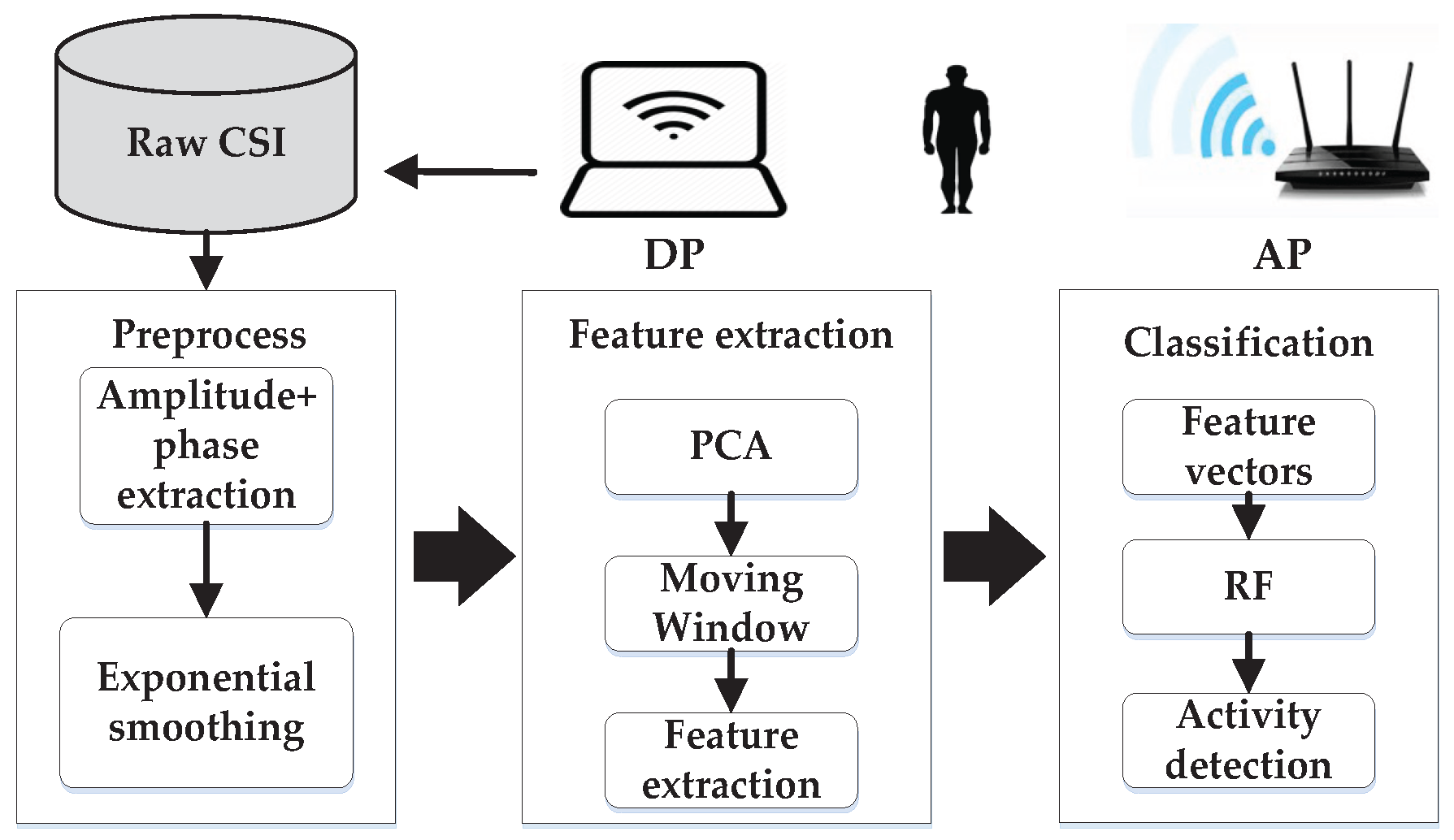
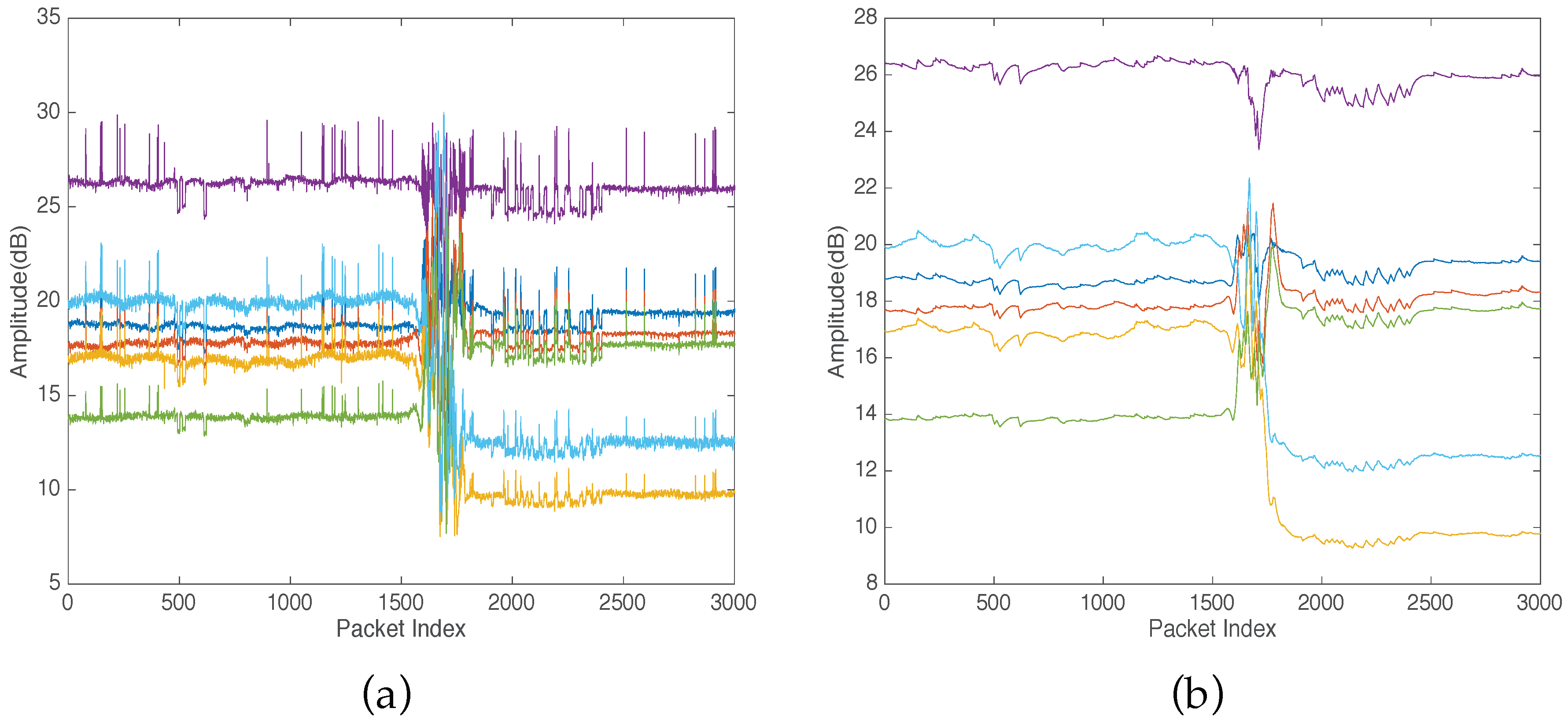
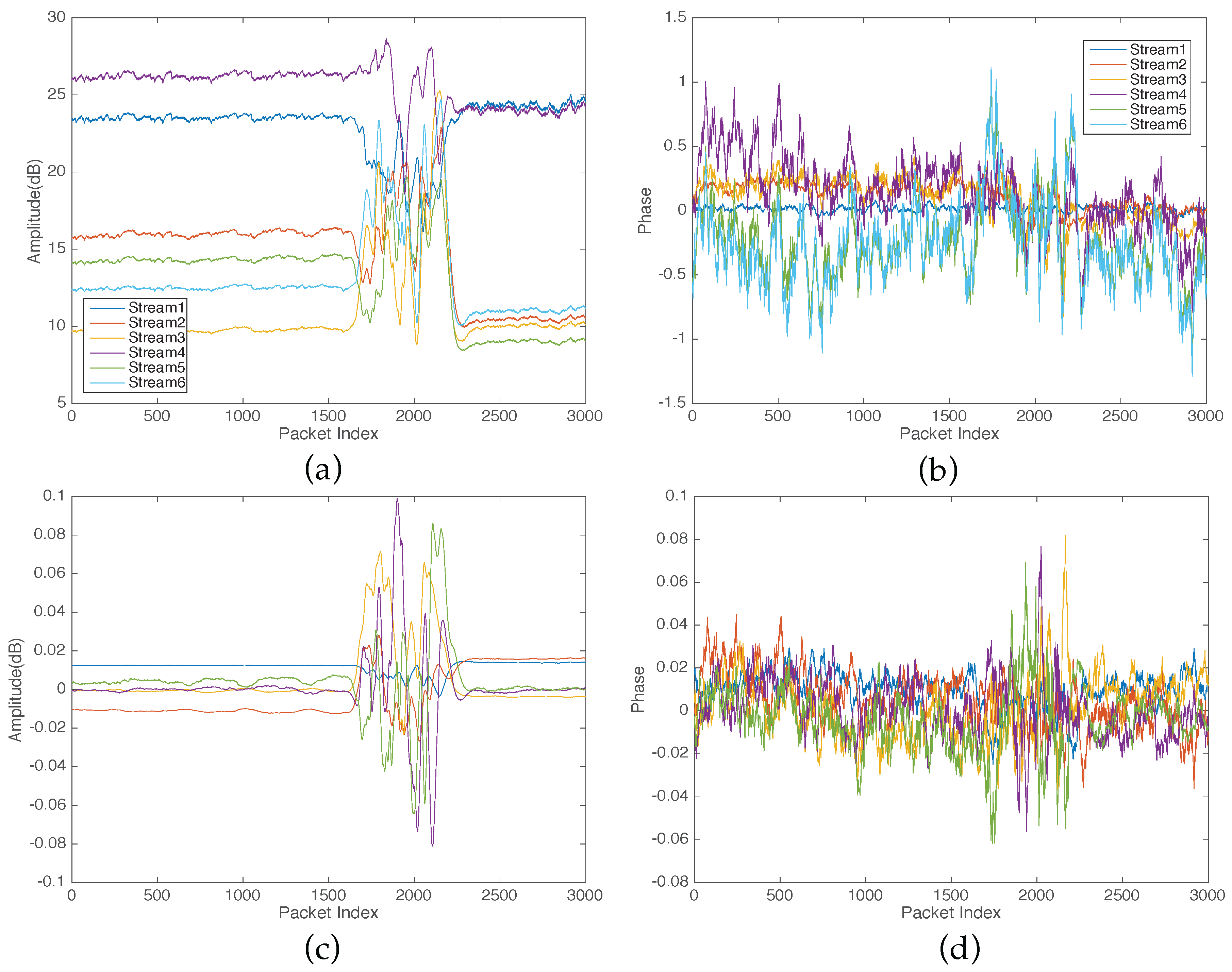
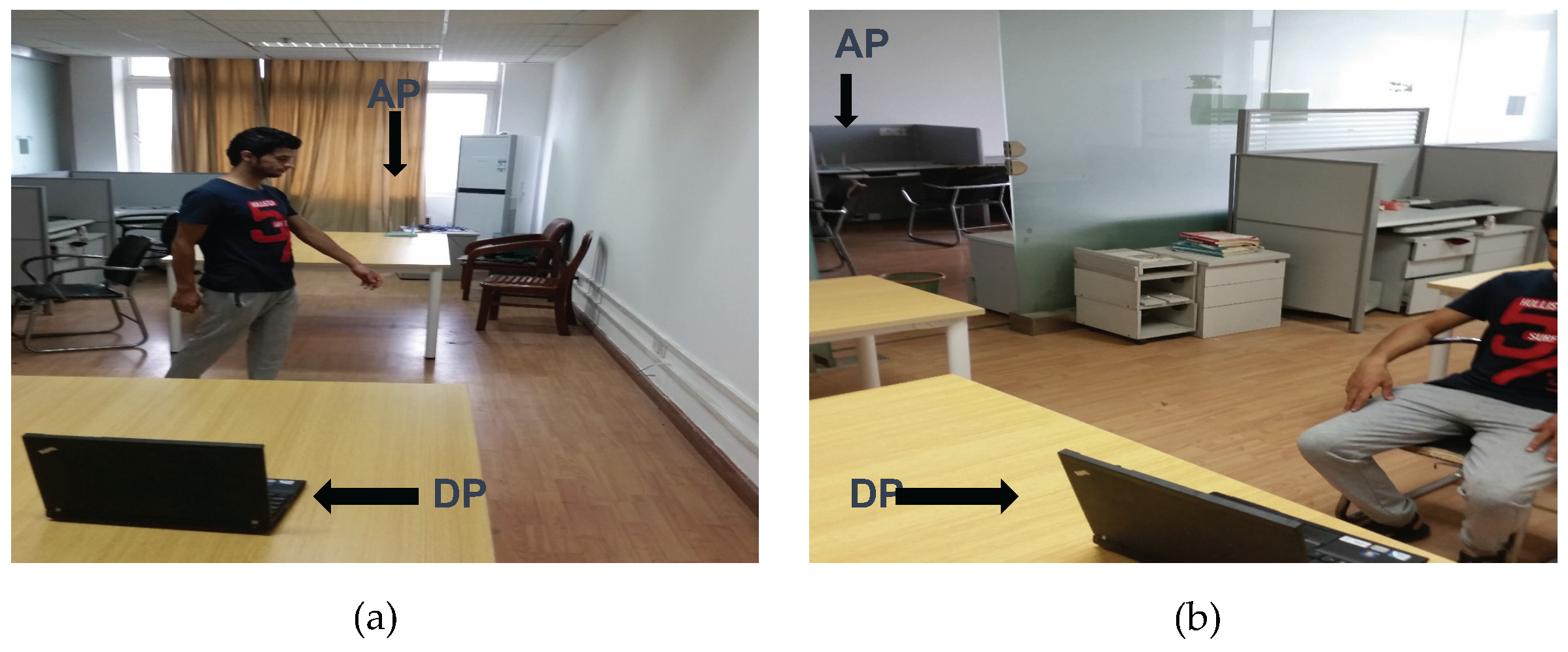

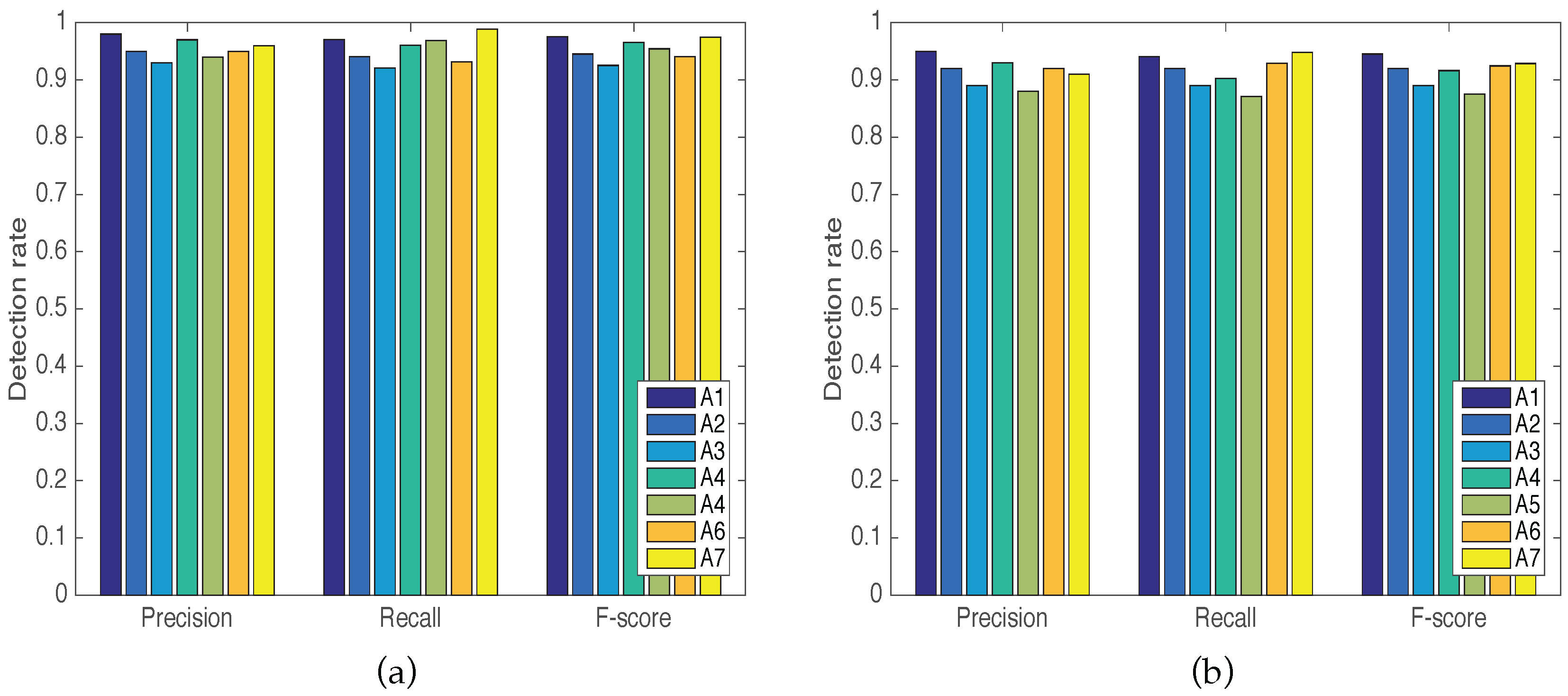

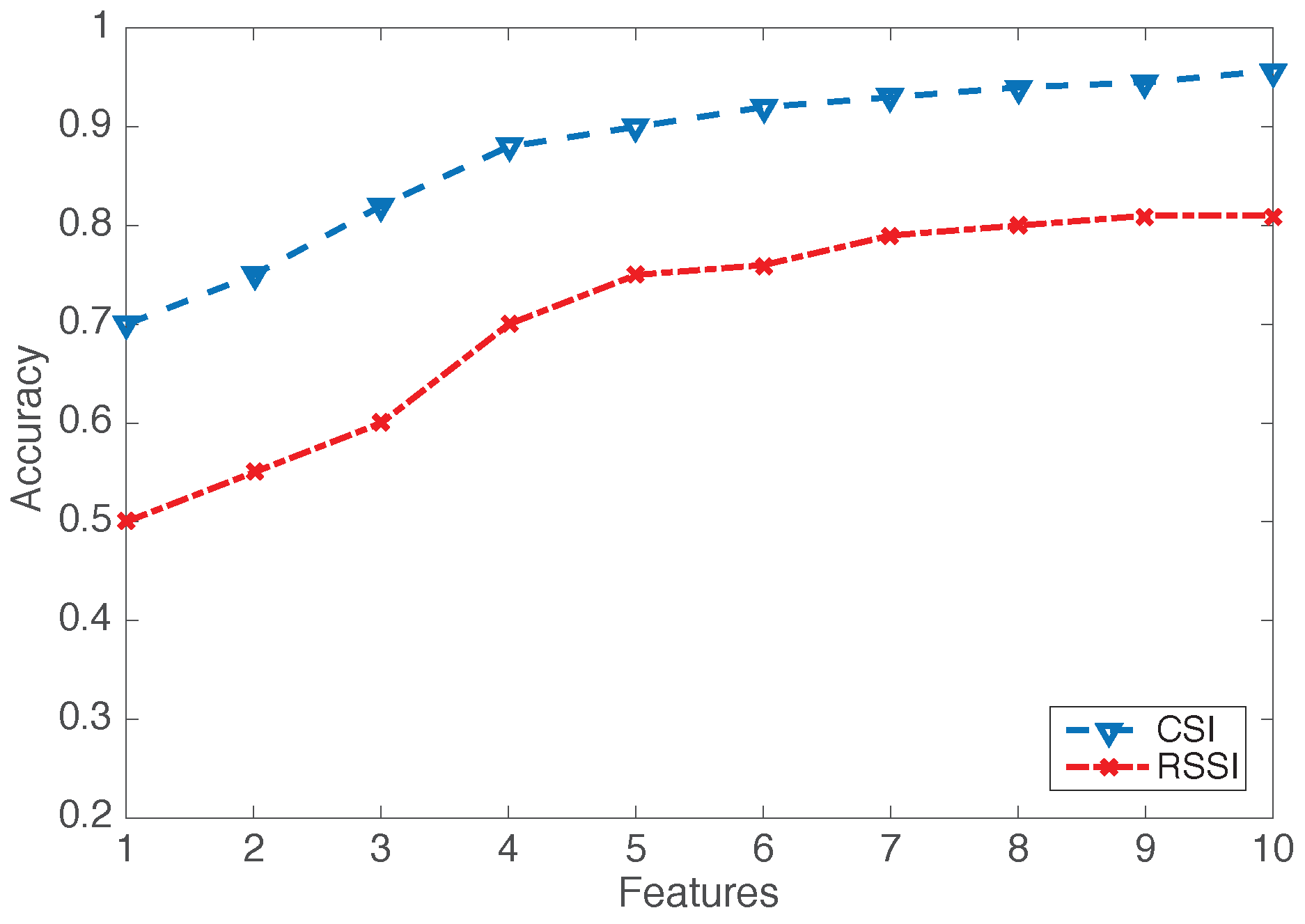
| Activity No. | Activity |
|---|---|
| A1 | Walk |
| A2 | Sit down |
| A3 | Lie |
| A4 | Stand up |
| A5 | Squat down |
| A6 | Fall |
| A7 | Crawl |
| Scenario | Collected Samples | No. of Groups | Samples per Group | No. of Samples per User in Each Group |
|---|---|---|---|---|
| Scenario 1 | 500 | 5 | 100 | 20 |
| Scenario 2 | 500 | 5 | 100 | 20 |
| Activity | RF | SVM | NBC |
|---|---|---|---|
| A 1 | 0.98 | 0.95 | 0.90 |
| A 2 | 0.95 | 0.91 | 0.82 |
| A 3 | 0.93 | 0.88 | 0.79 |
| A 4 | 0.97 | 0.92 | 0.83 |
| A 5 | 0.94 | 0.86 | 0.85 |
| A 6 | 0.95 | 0.93 | 0.80 |
| A 7 | 0.96 | 0.89 | 0.84 |
© 2016 by the authors; licensee MDPI, Basel, Switzerland. This article is an open access article distributed under the terms and conditions of the Creative Commons Attribution (CC-BY) license (http://creativecommons.org/licenses/by/4.0/).
Share and Cite
Li, F.; Al-qaness, M.A.A.; Zhang, Y.; Zhao, B.; Luan, X. A Robust and Device-Free System for the Recognition and Classification of Elderly Activities. Sensors 2016, 16, 2043. https://doi.org/10.3390/s16122043
Li F, Al-qaness MAA, Zhang Y, Zhao B, Luan X. A Robust and Device-Free System for the Recognition and Classification of Elderly Activities. Sensors. 2016; 16(12):2043. https://doi.org/10.3390/s16122043
Chicago/Turabian StyleLi, Fangmin, Mohammed Abdulaziz Aide Al-qaness, Yong Zhang, Bihai Zhao, and Xidao Luan. 2016. "A Robust and Device-Free System for the Recognition and Classification of Elderly Activities" Sensors 16, no. 12: 2043. https://doi.org/10.3390/s16122043







